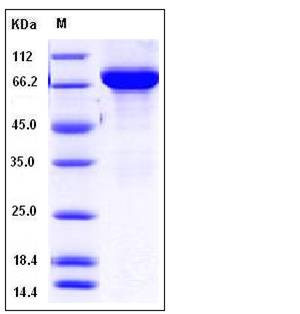Mouse THOP1 Protein (His Tag)
AI131655,AI327041,EP24.15
- 100ug (NPP2801) Please inquiry
| Catalog Number | P50828-M07B |
|---|---|
| Organism Species | Mouse |
| Host | Baculovirus-Insect Cells |
| Synonyms | AI131655,AI327041,EP24.15 |
| Molecular Weight | The recombinant mouse THOP1 consists of 705 amino acids and has a calculated molecular mass of 80.1 kDa. It migrates as an approximately 75 kDa band in SDS-PAGE under reducing conditions. |
| predicted N | Met |
| SDS-PAGE |  |
| Purity | > 90 % as determined by SDS-PAGE |
| Protein Construction | A DNA sequence encoding the mouse THOP1 (NP_073144.3) (Lys 2-Cys 687) was fused with a polyhistidine tag at the N-terminus. |
| Bio-activity | Measured by its ability to cleave a fluorogenic peptide substrate, (7-methoxycoumarin-4-yl)acetyl-Pro-Leu-Gly-Pro-D-Lys(2,4-dinitrophenyl)-OH or Mca-PLGPK(Dnp)-OH. The specific activity is > 500 pmoles/min/μg. |
| Research Area | Neuroscience |Cell Adhesion Proteins |Proteases |
| Formulation | Lyophilized from sterile 20mM Tris, 500mM NaCl, pH 7.4, 10% gly 1. Normally 5 % - 8 % trehalose and mannitol are added as protectants before lyophilization. Specific concentrations are included in the hardcopy of COA. |
| Background | THOP1, also known as Thimet oligopeptidase 1, Thimet oligopeptidase, EC 3.4.24.15, or EP24.15, is a zinc(II) endopeptidase implicated in the processing of numerous physiological peptides. As an intracellular enzyme, highly expressed in the brain, kidneys and neuroendocrine tissue, THOP1 has been proposed to metabolize peptides within cells, thereby affecting antigen presentation and G protein-coupled receptor signal transduction. Its substrates is gonadotrophin-releasing hormone (GnRH), an important hypothalamic hormone that regulates the synthesis and release of oestradiol and facilitates female sexual behaviour. THOP1 against toxic effects of Abeta in the early stages of Alzheimer disease (AD) pathology, and suggest that the observed increase in THOP1 expression might be part of a compensatory defense mechanism of the brain against an increased Abeta load. |
| Reference |
